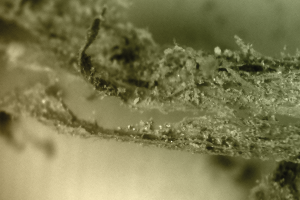(August 8, 2005 – CHARLESTON, SC) Today marks the fifth anniversary of the raising of the H. L. Hunley from the murky waters of the Atlantic Ocean. To commemorate the anniversary, Hunley officials traveled to the site where the submarine rested on the ocean floor for over a century. In a reverent ceremony, sediment excavated from the submarine was deposited into the water at 8.39 am, the exact minute the world got their first glimpse of the Hunley as she broke the water’s surface in 2000.
“The eyes of the world were upon this spot as the Hunley rejoined the light it had departed from 136 years ago. We came back here today to honor the Hunley crew’s legacy and symbolically return part of that legacy into the sea,” said Senator Glenn McConnell, Chairman of the Hunley Commission.
To celebrate the anniversary, Friends of the Hunley will unveil the Treasures from the Past exhibit starting August 13th during weekend tours of the submarine. The exhibit will include the gold ring and brooch Lt. Dixon was carrying in his pocket when he commanded the Hunley in 1864.
“This milestone anniversary reminds us of how much has been accomplished in five short years, but we still have much work left ahead to complete the Hunley’s final mission,” McConnell said.
The last phase of the project now entails conservation and solving the question that has eluded people for generations: Why did the Hunley vanish after becoming the world’s first successful combat submarine? Hunley officials announced today that approximately 8 million dollars will be needed to reach the finish line of the scientific project.
Archeologists are currently working to research and compile data that will ultimately solve the mystery of the Hunley’s disappearance. Discovering the truth behind the Hunley’s historic mission involves a complex investigation of the forensic analysis of the crewmen, the physical damage to the submarine, and studying the layers of sediment that formed within the sub.
Scientists are also at work to prepare the submarine for a conservation treatment as well as preserve the hundreds of artifacts found onboard the submarine. In collaboration with Clemson, the Hunley team developed a new metal treatment method scientists hope will decrease the time and funding needed for conserving other important marine artifacts.
“From the 19th to the 21st century, the Hunley continues to be a pioneering force in the advancement of technology,” McConnell said.
While the Hunley project team continues their work, North Charleston is beginning preliminary plans for the museum that will one day house the submarine and other significant maritime artifacts. City officials hope to have conceptual renderings early next year.
When the Hunley was recovered, few imagined how the last chapter of the submarine’s journey would unfold. Since 2000, the Hunley project has:
- Excavated the submarine, which was in essence a 19th century time capsule. Fascinating artifacts, including a gold coin that saved the life of Hunley commander George Dixon and a Union ID tag, were discovered.
- Buried the eight submarine pioneers that navigated the Hunley into world history at Magnolia Cemetery in Charleston, South Carolina. Their shared resting ground now serves as a monument to courage, innovation and sacrifice.
- Conducted ground-breaking research, including work that may help decrease health risks to first responders processing the remains of victims of anthrax or other deadly organisms.
- Earned a world-wide reputation in the fields of archeology and conservation. The Warren Lasch Conservation Center, which was created to work on the Hunley, has become an internationally recognized center for underwater archaeology and the conservation of marine artifacts. The U.S. Navy has called on the facility to handle historically significant artifacts, such as items recovered from the CSS Alabama and the Battle of Hampton Roads, one of the most famous naval battles in American history.
- Become a major tourist destination with over 250,000 visitors from all 50 states and over 20 countries having visited the lab during weekend tours.
- Received international media attention, including movies, documentaries and feature coverage on The History Channel, Discovery, National Geographic, The Today Show and dozens of other media outlets.
Friends of the Hunley
On the evening of February 17, 1864, the H. L. Hunley became the world’s first successful combat submarine by sinking the USS Housatonic. After signaling to shore that the mission had been accomplished, the submarine and her crew of eight vanished.
Lost at sea for over a century, the Hunley was located in 1995 by Clive Cussler’s National Underwater Marine Agency (NUMA). The hand-cranked vessel was raised in 2000 and delivered to the Warren Lasch Conservation Center, where an international team of scientists are at work conserving the vessel and piecing together clues to solve the mystery of her disappearance.
The material included in this press release is based upon work assisted by a grant from the Department of the Interior, National Park Service.


